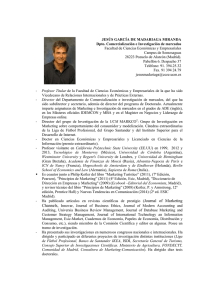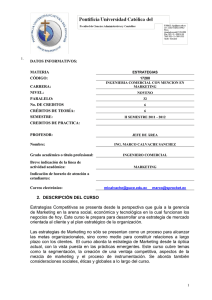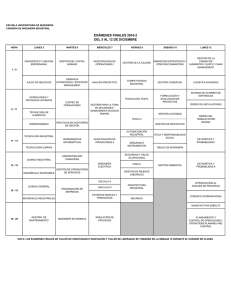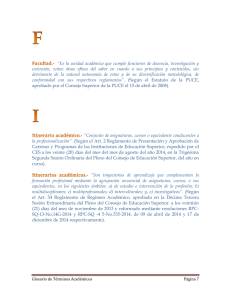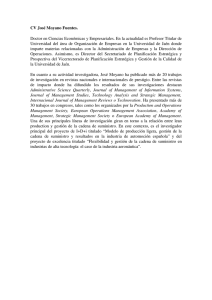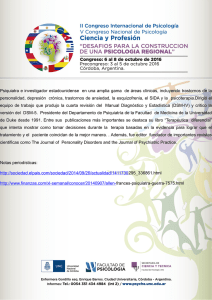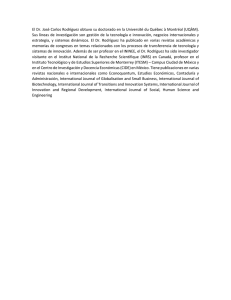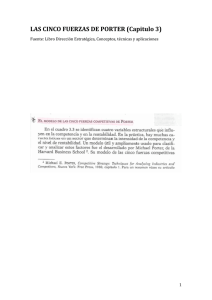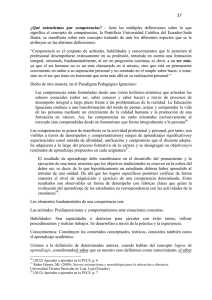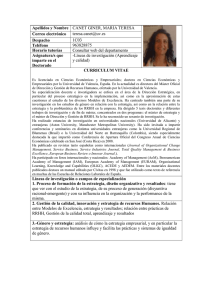I. DATOS INFORMATIVOS MATERIA: ESTRATEGIAS
Anuncio
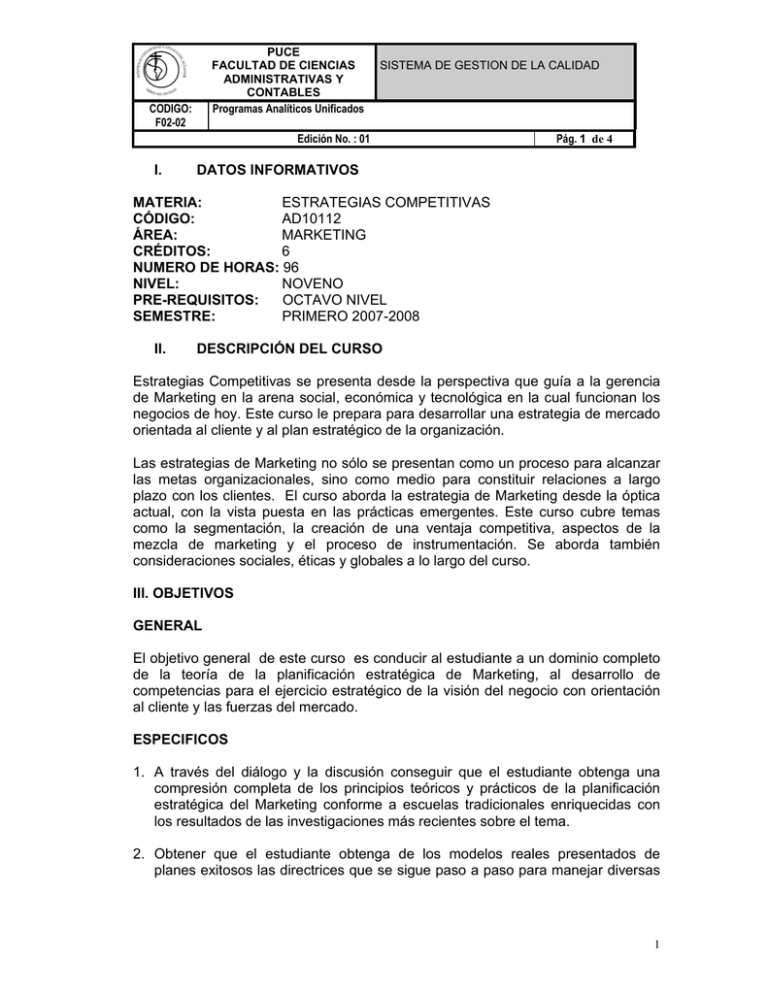
PUCE FACULTAD DE CIENCIAS ADMINISTRATIVAS Y CONTABLES Programas Analíticos Unificados CODIGO: F02-02 SISTEMA DE GESTION DE LA CALIDAD Edición No. : 01 I. Pág. 1 de 4 DATOS INFORMATIVOS MATERIA: ESTRATEGIAS COMPETITIVAS CÓDIGO: AD10112 ÁREA: MARKETING CRÉDITOS: 6 NUMERO DE HORAS: 96 NIVEL: NOVENO PRE-REQUISITOS: OCTAVO NIVEL SEMESTRE: PRIMERO 2007-2008 II. DESCRIPCIÓN DEL CURSO Estrategias Competitivas se presenta desde la perspectiva que guía a la gerencia de Marketing en la arena social, económica y tecnológica en la cual funcionan los negocios de hoy. Este curso le prepara para desarrollar una estrategia de mercado orientada al cliente y al plan estratégico de la organización. Las estrategias de Marketing no sólo se presentan como un proceso para alcanzar las metas organizacionales, sino como medio para constituir relaciones a largo plazo con los clientes. El curso aborda la estrategia de Marketing desde la óptica actual, con la vista puesta en las prácticas emergentes. Este curso cubre temas como la segmentación, la creación de una ventaja competitiva, aspectos de la mezcla de marketing y el proceso de instrumentación. Se aborda también consideraciones sociales, éticas y globales a lo largo del curso. III. OBJETIVOS GENERAL El objetivo general de este curso es conducir al estudiante a un dominio completo de la teoría de la planificación estratégica de Marketing, al desarrollo de competencias para el ejercicio estratégico de la visión del negocio con orientación al cliente y las fuerzas del mercado. ESPECIFICOS 1. A través del diálogo y la discusión conseguir que el estudiante obtenga una compresión completa de los principios teóricos y prácticos de la planificación estratégica del Marketing conforme a escuelas tradicionales enriquecidas con los resultados de las investigaciones más recientes sobre el tema. 2. Obtener que el estudiante obtenga de los modelos reales presentados de planes exitosos las directrices que se sigue paso a paso para manejar diversas 1 CODIGO: F02-02 PUCE FACULTAD DE CIENCIAS ADMINISTRATIVAS Y CONTABLES Programas Analíticos Unificados SISTEMA DE GESTION DE LA CALIDAD Edición No. : 01 Pág. 2 de 4 funciones estratégicas: fijar objetivos, elogiar y dar instrucciones, entrenar a los seguidores, resolver conflictos y negociar. 3. Ejercitar al estudiante en la aplicación de los principios, competencias y funciones a casos reales para desarrollar sus competencias y capacidad de sentido crítico. 4. Dominar competencias de la planificación estratégica del Marketing, en especial el cómo y por qué de cada una de sus partes constitutivas: análisis SWOT, segmentación, posicionamiento, fijación de precios, relaciones con los clientes mediante calidad, valor y satisfacción, estrategia de producto, administración de la cadena de distribución y suministro, comunicaciones integradas de Marketing. IV UNIDADES DE APRENDIZAJE INTRODUCCION: EL MARKETING Y LA NUEVA ECONOMIA PARTE I: PLANIFICACION ESTRATEGICA DE MARKETING (20%) 1. Estructura del plan de Marketing 2. Análisis situacional y del entorno 3. Análisis SWOT: desarrollo de la estrategia de Marketing. 4. Segmentación del mercado, marketing meta, posicionamiento. PARTE II: RELACIONES CON LOS CLIENTES MEDIANTE CALIDAD, VALOR Y SATISFACCION (15%) 5. 6. 7. 8. Administración de relaciones con el cliente. Función de la calidad en el establecimiento de relaciones con el cliente. Crear valor para establecer relaciones con el cliente. Cómo mantener al cliente satisfecho a largo plazo PARTE III: ESTRATEGIA DE PRODUCTO Y PRECIO (15%) 09. 10. 11. 12. 13. Desarrollo de nuevos productos. Ciclo de vida Marketing de servicios. Estrategia de marca. Creación de una estrategia de fijación de precios. PARTE IV: ADMINISTRACION DE LA SUMINISTRO (15%) CADENA DE DISTRIBUCION Y 14. Aspectos estratégicos de la estructura de la cadena 2 CODIGO: F02-02 PUCE FACULTAD DE CIENCIAS ADMINISTRATIVAS Y CONTABLES Programas Analíticos Unificados SISTEMA DE GESTION DE LA CALIDAD Edición No. : 01 Pág. 3 de 4 15. Tendencias en los canales de Marketing. PARTE QUINTA: COMUNICACIONES INTEGRADAS DE MARKETING (25%) 16. Modalidades de publicidad 17. Relaciones Públicas 18. Manejo estratégico de la fuerza de ventas PARTE SEXTA: INSTRUMENTACION Y CONTROL DE MARKETING (10%) 19. 20. 21. 22. Elementos de la instrumentación y control de Marketing. Marketing interno Evaluación y control de las actividades de Marketing Análisis financiero para la toma de decisiones de Marketing. V. METODOLOGIA Y RECURSOS En el desarrollo del syllabus el profesor de la asignatura establecerá el ritmo del curso y dará la prioridad a cada área de acuerdo a su importancia. A modo de sugerencia en la descripción de cada unidad está señalado un porcentaje tentativo del tiempo total del semestre, dada la importancia del tema clave. En lo posible cada sesión deberá partir de un caso práctico que deberá luego ser analizado por los estudiantes con la respectiva retroalimentación del instructor. Se requiere que los estudiantes lean el capítulo correspondiente del texto antes de clase a fin de que puedan analizar y discutir el caso. La presentación del caso podrá hacerse mediante un documental en video o tomando la información del sitio Web de la empresa que se va a estudiar. A fin de asegurar la lectura del texto el profesor controlará la realización de los ejercicios y cuestionarios que se encuentran en el sitio Web del texto. Allí se encontrarán también las diapositivas correspondientes a cada capítulo. Si utilizan el texto de Thomson, encontrarán en el Companion Web del editorial abundantes recursos, links, casos y sugerencias para el tratamiento de cada tema. El uso de estos recursos permite al estudiante experimentar el mundo globalizado real. Implica que utilicen de manera intensiva el idioma inglés. Estudiantes y profesores pueden pedir asistencia al coordinador del área de Marketing. Todas las editoriales ofrecen abundantes recursos para el instructor. El coordinador de su área le podrá ayudar para recibir los sitios web, nombre de usuario y contraseña para el uso de dichas ayudas. 3 CODIGO: F02-02 PUCE FACULTAD DE CIENCIAS ADMINISTRATIVAS Y CONTABLES Programas Analíticos Unificados SISTEMA DE GESTION DE LA CALIDAD Edición No. : 01 Pág. 4 de 4 VI. EVALUACIÓN Se sugiere seguir esta tabla para la evaluación o un sistema similar tendiendo en cuenta la filosofía del aprendizaje de adultos: Resolución de los cuestionarios Resolución de casos Participación en clase Proyecto final (en grupo) 10 puntos 10 puntos 10 puntos 20 puntos Como examen final se recomienda solicitar a los estudiantes trabajar en grupo un proyecto real de investigación sobre uno de los tópicos del programa: por ejemplo diseño del plan de marketing de un producto, análisis del plan de marketing de una empresa de renombre y rediseño del mismo. Para este curso se recomienda participar en el concurso Marketing Challenge de la organización Junior Achievement durante el cual podrán nuestros estudiantes medir fuerzas con otras universidades. VII. BIBLIOGRAFÍA Textos recomendados: O.C. Ferrell, Michael Hartline, George Lucas, (2007), Estrategias de Marketing. México: Thomson Learning. Proctor, T. (2000), Strategic Marketing: An Introduction. London: Routledge. Nota: el profesor puede escoger otro texto siempre y cuando sea texto universitario actualizado, no más de tres años de edición y con los elementos didácticos para organizar el curso. Es obligatorio utilizar un texto y acostumbrar a los estudiantes a la lectura abundante. BIBLIOGRAFIA PARA CONSULTA Para aprovechar esta bibliografía de apoyo, deberán usar la biblioteca virtual EBSCO, que la encuentran en la página Web de la PUCE. El URL es: http://search.epnet.com/login.aspx?authtype=uid USUARIO: peri CONTRASEÑA: ecuador1 En el sitio web de la PUCE, en biblioteca se encuentran otras bibliotecas y libros virtuales. Se recomienda usar Thomson-Gale, Quest, y la colección de E-books o la biblioteca virtual QUESTIA. Pueden acceder desde sus casas, consulten en la 4 CODIGO: F02-02 PUCE FACULTAD DE CIENCIAS ADMINISTRATIVAS Y CONTABLES Programas Analíticos Unificados SISTEMA DE GESTION DE LA CALIDAD Edición No. : 01 Biblioteca General para que Pág. 5 de 4 tengan la respectiva contraseña. Aaker, D. (1995), Strategic Marketing Management (4th Edition), chapter 2, p. 35, Chichester: John Wiley. Achrol, R.S. (1991), ‘Evolution of the marketing organisation: new forms for turbulent environments’, Journal of Marketing 55:77-93. Ackoff, R.L. and Vegara, E. (1988), ‘Creativity in problem solving and planning’, in R.L. Kuhn (ed.), Handbook for creative and innovative managers, New York: McGraw Hill. Assael, H. in Consumer Behaviour and Marketing (1987), Kent Publishing, p. 87, gives a more elaborate classification of purchasing decisions. Azzolini, M. and Shillaber, J. (1993), ‘Internal service quality: Winning from the inside out’, Quality Progress, November: pp. 75-8. Bateson, J.E.G. (1995), Marketing Services: Marketing Text and Readings, Orlando, Florida: The Dryden Press, pp. 149-51, 262, 274-6. Boston Consulting Group (1979), Specialization, Boston: BCG. Brooks, R.F. (1995), ‘Internal service quality—a theoretical development’, Proceedings of the Marketing Education Group, Bradford, pp. 80-90. Brown, S. (1999), ‘Postmodernism: The End of Marketing’, in D. Brownlie, M. Saren, R. Wensley and R. Whittington Rethinking Marketing, London: Sage, pp. 27-57. Brown, T.J. and Dacin, P.A. (1997), ‘The company and the product: Corporate associations and consumer product responses’, Journal of Marketing, 61, January, pp. 68-84. Cronin, J.J. and Taylor, S.A. (1992), ‘Measuring service quality: a re-examination and extension’, Journal of Marketing, 56:55-68. Crenshaw, M., Davis, E. and Kay, J. (1994), ‘On being stuck in the middle or good food costs less at Sainsbury’s’, British Journal of Management, 5:19-32. Day, G.S. (1990), Market Driven Strategy, Processes for Creating Value, New York: The Free Press. Day, G.S. (1993), The Capabilities of Market-driven Organizations, Cambridge, Massachusetts: Marketing Science Institute. Delaney, Joan (1994) Crafting a Marketing Plan That Works. Magazine Title: Black Enterprise. Volume: 25. Issue: 4. Publication Date: November 1994. Page Number: 120+. Earl G. Graves Publishing Co., Inc.; COPYRIGHT 2002 Gale Group 5 CODIGO: F02-02 PUCE FACULTAD DE CIENCIAS ADMINISTRATIVAS Y CONTABLES Programas Analíticos Unificados Edición No. : 01 SISTEMA DE GESTION DE LA CALIDAD Pág. 6 de 4 Egan, C. (1998), ‘Market dynamics and marketing strategies’, in C. Egan, and M.J. Thomas (eds), The CIM Book of Strategic Marketing, Oxford: Butterworth Heinemann. Eisenhardt, K.M. and Brown, S.L. (1999), ‘Patching—re-stitching business portfolios in dynamic markets’, Harvard Business Review, May/June. Ekvall, G. (1988), ‘Change centered leaders: empirical evidence of a third dimension of leadership’. Creativity and Innovation Year-book, 1:36-46. Evans, M. and Moutinho, L. (1999), Contemporary Issues in Marketing, Basingstoke: Macmillan, p. 81. Firat, A.F. and Venkatesh, A. (1995), ‘Liberatory postmodernism and the reenchantment of consumption’, Journal of Consumer Research, 22:239-67. Fisher, R.J., Maltz, E. and Jaworski, B.J. (1997), ‘Enhancing communication between marketing and engineering: the moderating role of relative functional identification’, Journal of Marketing, 61:54-70. Grant, R.M. (1996), ‘Prospering in dynamically-competitive environments: organizational capability as knowledge integration’, Organizational Science, 7: 37587. Haley, R.I. (1968), ‘Benefit segmentation. A decision-oriented research tool’, Journal of Marketing, 32:30-5. Halliburton, C. and Hunerberg, R. (1993) ‘Marketing in a European Environment’, in C. Haliburton and R. Hunerberg (eds), European Marketing: Readings and Cases, Cambridge: Addison Wesley. Heskett, J.L., Jones, T.O., Loveman, G.W., Sasser, W.E. and Schlesinger, L.A. (1994), ‘Putting the service profit chain to work’, Harvard Business Review, MarchApril, pp. 164-74. Heskett, J.L. (1987), ‘Lessons in the services sector’, Harvard Business Review, 87(2):118-26. Higgins, J.M. (1994), The Management Challenge (2nd edition), New York: Macmillan, p. 486. Holliday, Karen Keller (2005) “Why They Sell: A Look Behind the Headlines at Seller Motivation, Buyer Strategies, and the Overall M&A Outlook.” ABA Banking Journal. Volume: 97. Issue: 4. Page Number: 27+. Simmons-Boardman Publishing Corporation; Gale Group Hunt, S. and Morgan, R.M. (1995), ‘The comparative advantage theory of competition’, Journal of Marketing, 59:1-15. 6 CODIGO: F02-02 PUCE FACULTAD DE CIENCIAS ADMINISTRATIVAS Y CONTABLES Programas Analíticos Unificados Edición No. : 01 SISTEMA DE GESTION DE LA CALIDAD Pág. 7 de 4 Jaworski, B.J. and Kohli, A.K. (1993), ‘Market orientation: antecedents and consequences’, Journal of Marketing, 57:53-70. Kohli, A.K. and Jaworski, B.J. (1990), ‘Market orientation: the construct, research propositions and managerial implications’, Journal of Marketing, 54:1-18. Kontes, P.W. and Mankins, M.C. (1992), ‘Is global market leadership worth it?’ Across the Board, 29(10):13-15. Kotler, P. (1988), Marketing Management: Analysis, Planning and Control, Englewood Cliffs, NJ: Prentice Hall. Kotler, P. and Lilien, G. (1983), Marketing Decision Making: A Model Building Approach, New York: Harper and Row. Kotter, J. (1997), ‘Rethinking leadership’ in R. Gibson (ed), Rethinking the Future, London: Nicholas Brealey, p. 166-7. Large, M. (1992), ‘Eco-mapping—how to avoid boiled frogs’, Management Education and Development, 23(4):317-25. Levitt, T. (1960), ‘Marketing myopia’, Harvard Business Review, July-August, pp. 45-56. Mathur, S.S. (1992), ‘Talking straight about competitive strategy’, Journal of Marketing Management, 8:199-217. McCarthy, E.J. and Perreault, W.D. (1993), Basic Marketing, 11th edition, Chicago, Illinois: p. 299. McDonald, M.H.B. (1989), Marketing Plans (2nd edition), Oxford: Heinemann. Mills, R.W. (1994), Finance, Strategy and Strategic Value Analysis, Slough: Mars Business Associates, UK. Mintzberg, H. and Quinn, J.B. (1991), The Strategy Process, Englewood Cliffs, NJ: Prentice Hall. Mitchell, A. (1995), ‘Holidays: what lays behind the big discounts’, The Times, 4th January, p. 19. Narver, J.C. and Slater, S.F. (1990), ‘The effect of a market orientation on profitability’, Journal of Marketing, 54(4), 20-35. Normann, R. and Ramirez, R. (1993), ‘From value chain to value constellation: designing interactive strategy’, Harvard Business Review, July/August. Oldman, G.R. and Cummings, A. (1996), ‘Employee creativity: Personal and contextual factors at Work’, Academy of Management Journal, June, Vol. 39. 7 CODIGO: F02-02 PUCE FACULTAD DE CIENCIAS ADMINISTRATIVAS Y CONTABLES Programas Analíticos Unificados Edición No. : 01 SISTEMA DE GESTION DE LA CALIDAD Pág. 8 de 4 Osgood, C., Suci, G. and Tannenbaum, P. (1987), The Measurement of Meaning, Urbana: University of Illinois Press. Ouchi, W.G. and Bolton, M. (1988), ‘The Logic of Joint Research and Development’, California Management Review, No. 3, Spring. Parasuraman, A., Berry, L.L. and Zeithaml, V.A. (1991), ‘Understanding customer expectations of service’, Sloan Management Review, 32(3):39-48. Porter, M. (1980a), Competitive Strategy, New York: The Free Press. Porter, M.E. (1980b), ‘How competition forces shape strategy’, Harvard Business Review, September-October, pp. 137-45. Porter, M.E. (1985) Competitive Advantage, New York: The Free Press. Porter, M.E. (1987), ‘Michael Porter on competitive strategy reflections and round table discussions’, European Management Journal, 6(1):2-9. Porter, M.E. (1988), Video film and pamphlet: Michael Porter on Competitive Strategy, Harvard Business School Video Series. Prahalad, C.K. and Hamel, G. (1990), ‘The core competence of the corporation’, Harvard Business Review, May-June, pp. 79-91. Proctor, R.A. (Tony) (1989), ‘Innovations in new product screening and evaluation’, Technology Analysis and Strategic Management, 1(3):313-23. Proctor, R.A. and Kitchen, P.J. (1990), ‘Strategic planning: An overview of product portfolio models’, Marketing Intelligence and Planning, 8(7):4-10. Proctor, T. (1993), ‘Product innovation: The pitfalls of Entrapment’, Creativity and Innovation Management, 2(4):260-5. Proctor, T. (2000), Essentials of Marketing Research, London: FT/Prentice Hall. Proctor, T. (2000), Strategic Marketing: An Introduction. London: Routledge. Przybylowicz, E.P. and Faulkner T.W. (1993), ‘Kodak applies strategic intent to the management of technology’, Research-Technology Management, 36(1):31-8. Quinn, J.B., Doorley, T.L. and Paquette, P.C. (1990), ‘Beyond products: Servicesbased strategy’, Harvard Business Review, March-April, pp. 58-68. Ringland, G. (1998), Scenario Planning, Managing for the Future, Chichester: John Wiley. Rogers, B. (1996), Creating Product Strategies, London: International Thompson. 8 CODIGO: F02-02 PUCE FACULTAD DE CIENCIAS ADMINISTRATIVAS Y CONTABLES Programas Analíticos Unificados SISTEMA DE GESTION DE LA CALIDAD Edición No. : 01 Pág. 9 de 4 Sherrington, M. (1995), ‘Branding and brand management’, in M.J. Baker (ed), Companion Encyclopedia of Marketing, London: Routledge, p. 509. Speed, R.J. (1989), ‘Oh Mr. Porter! A re-appraisal of competitive strategy’, MIP, 7: 8-11. Teas, R.K. (1993), ‘Expectations, performance evaluation, and consumers’ perceptions of quality’, Journal of Marketing, 57(4):18-34. Weihrich, H. (1982), ‘The TOWS Matrix: A tool for situational analyses, Journal ofLong Range Planning, 15(2):54-66. MINIMOS PARA APROBAR LA MATERIA: MINIMO EXAMEN FINAL 8/20 MINIMO TOTAL (50) 30/50 9
